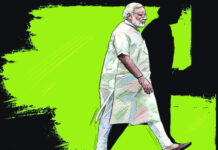In the past few years, soan papdis have become the butt of jokes and memes on social media. There is even data to prove how disliked it is.
Diwali is back and the markets are brimming with sweets, streets are echoing the boom of crackers and air… Well, the less said about it, the better. However, there’s no joy in festivities without adding some extra sugar and calories to it.
Thanks to India’s diversity, we have so many varieties of sweets that I can write an opinion about each one of them. But for this one, I am going to limit myself to the most hated one — Soan Papdi.
For the last few years, I have been seeing jokes and memes on social media about this sweet created out of gram flour, maida, sugar, and ghee. You can have a look at some of the wittiest ones on this Twitter page. But what’s with the contempt against Soan Papdi? How does a simple affordable sweet become a subject of hate?
The answer lies in its economics.
The interest in Soan Papdi
When I used Google trends data to look for statistics about people’s interest in buying sweets, I got some explanation. Compared to our all-time favourites — Gulab Jamun, Rasgulla, Kaju Katli, and Barfi — the poor Soan Papdi didn’t even make the cut.
The top queries about every mithai translated into its price. People usually look at the price per kilo of a particular sweet, or if it’s a specialty of some restaurant, they will also add its name in their Google search.
Data shows that on an average between 1 and 29 October this year, Rasgulla was the most searched mithais with a score of 71, followed by Gulab Jamun (61), Barfi (57), and Kaju Katli (34). Soan Papdi got a meager score of only 23 and it’s not just this year. The trend was similar during the corresponding period last year.
So it’s clear when someone is looking at the price of sweets, Soan Papdi isn’t the natural choice. So when they receive the same completely out of the blue, why won’t they feel bad?
A barometer of relationships
The contempt against a relative giving you the Soan Papdi also depends on your attachment level. So if a very close relative, who is above everyone else, gets the most special gift you can afford, the ones who you do not like at all, deserve the least you can give — Soan Papdi.
In my observation, however, Soan Papdi can’t be given as a standalone gift to the near and dear ones. So our very smart moms usually pass it on to relatives with something much more valuable, like a set of glasses/cutlery, bowls, etc. By doing this, neither does the relative find the Soan Papdi offensive nor do we feel the guilt of disposing of it — killing two birds with one stone.
If you do have to give standalone sweets, the top tier usually gets dry fruits, artisanal chocolates, Kaju Katli, Gajar Pak/Halwa, and Milk cakes from a local specialist.
Just Soan Papdi and nothing else is a sign to mend your relationship with the giver. Maybe start by not giving them Soan Papdi as a return gift? Things are different if a person adores Soan Papdi. No offense, but most people do not consume it in bulk the way they do with other sweets.
If you are not close to someone yet receive Soan Papdi from them, treat it as gold, my dear friend. After all, Diwali is not just a festival of lights and crackers but also a festival of celebrating the joy of gifting. Maybe it could be the start of something new.
Microeconomics of sweets
All students who studied economics in high school can understand the law of diminishing returns. Now, for those who didn’t, I have a golden chance to explain it using the venerable Soan Papdi as an example.
Think of a box of Gulab Jamun. When you have the first one, you get extremely happy. So happy that you eat another one. Remember, with every additional Gulab Jamun that you eat, your desire to eat more goes down. In complicated economic jargon, this is a basic law that defines your preference for something you have already consumed.
One can think of eating more pieces of Gulab Jamun or Rasgulla because they are smaller, tastier, and sometimes come with fillings. This Rakshabandhan, I had no choice but to eat nine Gulab Jamuns in fifteen minutes. But I did it quite comfortably.
Could I have done it with a Soan Papdi? No way. I remember the tiny complimentary pack given to the travelers in Shatabdi Express. I could eat it without guilt because it was small. But the bigger size that this sweet comes in is a problem, especially when you’re the only one eating it. You need something liquid, like milk or tea with it. Also, some variants are prickly, they hurt the tongue.
If you force me to eat one additional Soan Papdi, all I’ll ever see are red flags. Every additional Soan Papdi will make me feel worse and add to the negative returns or dissatisfaction.
When you give a gift to 10 people, you also expect 10 in return, but if half of them are Soan Papdis, won’t you feel depressed? A family can consume one box a week, but 10 boxes? It might just be better to forward it as received, applying the law of karma, what goes around comes back around.
Jokes apart, this Diwalinomics piece is entirely based on my personal experience so don’t take it to heart. Gift as you like and enjoy a safe and sugary Diwali. #livehyd #hydnews






